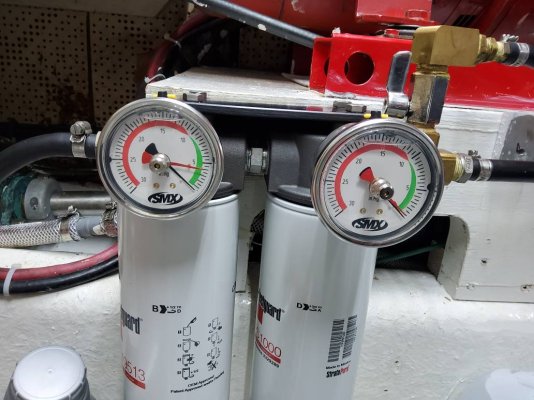There are many who believe that dual Racors are a must. I am not one of them. I would be happy to have them on a boat that I purchased but I would not pay $1,200 x two to retrofit. If anything, I would add another filter head and associated plumbing to enable a quick changeover but not the wildly expensive Racors. I will address several of the previous comments/observations.
Yes, I have had occasion to change a filter in a pitching sea. The offending filter was one of those clamshell types, the on-engine filters found on Perkins and Lehmans. One of the square o-rings had started leaking. It was not fun especially because the filter was on the back side of the engine and that damn engine was hot. I have since since converted those filter heads to spin-on assemblies. Not fun but I got it done. I have been in plenty of rough seas and my primary filters have never plugged up. My tanks are very clean. The boat came to me that way.
As for rough water stirring up gunk, I suppose if the boat were new to the owner and the condition of the tanks were unknown, this might be a concern. But, after owning and using a boat for while, gunk in the tank will make its existence known fairly quickly and the problem can be dealt with in some fashion. And, with continued use, that gunk will be filtered out such that it is no longer an issue. If one has a fuel polishing system, gunk should never be a problem so no need for duals.
Sure, one might - a very remote possibility in the US and Canada - take on a bad load of fuel but this would be a rarity and, in my mind does not justify spending new money on dual Racors. Besides, if it were I, and I were going off-shore, I would closely monitor my vacuum gauges with a new fuel addition to see if there is going to be a problem. The fact is, very few boat owners venture out more than one day. Even with a bad load of fuel or crappy tanks, if the captain is paying attention to his vacuum gauges, a stoppage is user error. Plenty of time to reach a calm anchorage or marina at which to change a filter comfortably.
And that brings me to the comments about surprise stoppages. Yes, some engine rooms are not very accessible but waiting for a filter to plug up and then accessing the engine room to flip the Racor switch, my goodness. And what happens when that crappy tank that just so very quickly clogged up the first filter now quickly clogs up the second filter? Yup, down below to change the filters in a pitching sea. Waiting for a stumbling engine to change a filter seems unwise to me. Monitor the gauge. If you are paying attention you will not be surprised. If you can't get to your engine room easily, do as Rich(rgano) does, install remote vacuum gauges. When the filter starts to get close to the red zone, change it.
Here's a quote - "I installed the dual Raycors with pressure gauge… first sputter I shut down, lift the hood and switch from A to B and deal with the clogged filter under better circumstances." First of all it is a vacuum gauge but why or why do you wait until it is a problem? Why bother with a vacuum gauge if you don't use it to change filters timely?
Another thing I don't get - for those folks with vacuum gauges, are you observing them each day before you get under way. You know, check the lube oil, transmission fluid, and general inspection for other potential problems? Or, are you that guy who just starts them up and goes trusting to luck. Seems to me that if proper pre-start procedures are followed a nearly-consumed filter would be evident BEFORE going off-shore.




